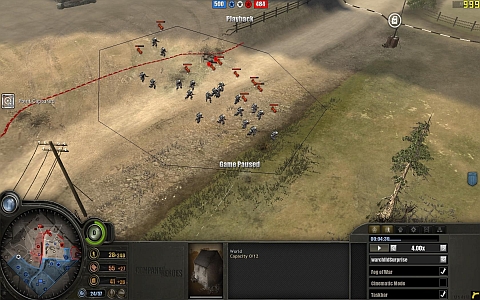"And if we are able thus to attack an inferior force
with a superior one, our opponents will be in dire straits." - The Art of War, chapter 6
This is easily one of the most important things I can teach you about CoH. I got to where I am in CoH today almost entirely on distributing my forces better than my opponents could. It's probably not something you have thought about that much, but if you want to get better at CoH, it's something you're going to have to think about very hard now.
In its most basic, force distribution is spreading out your units on the field to defeat your enemy. A very simple example is spreading out two Rifleman squads to beat 2 Volks squads. The Rifleman will do this by grouping up together, and finding an isolated Volks squad that they will beat with ease, and then moving on to the next squad of Volks that don't have the reinforcements to save them because those were already chased off by the Rifleman squads. You should generally try to out-number or out-gun your opponent with a stronger force, while leaving at least part of his units out of the fight. Take a look at example picture one, its hard to see it on the screen but here I have four Rifleman squads engaging two Panzer Grenadier squads. In example picture 2 you can see that I have forced my opponent's Panzer Grenadiers to retreat. This makes fighting his remaining Panzer Grenadiers on the field a lot easier, because I will outnumber him again. Go for where your opponent is weak with your strong forces, and avoid his strong forces when you have weak ones.
"That the impact of your army may be like a grindstone
dashed against an egg--this is effected by the science
of weak points and strong." - The Art of War, Chapter 5
To do things like this successfully, you need to know or at least guess where your opponent has put his units. This is a lot harder than it sounds, you will need to have some ability to actually see where your opponent's units are. To some extent, you can use your strategic points to look but that depends entirely on if your opponent is around a point you control. Your opponent won't just stick his units right front of you for you to see and exploit. In the early game I use my Jeeps or Kettenrads, and the Bren Carrier works fairly good too. Remember that when you send these units out you are not fighting, just looking, stay at a good distance so you won't take much damage. After you find out how your opponent has positioned his forces, you should find out how to attack them most effectively. Sometimes that means just defending the area your opponent is going to attack in the best way you can. For a little more detail in this read my Attack and Defense article. For a good example of this see the example screen shots, as it's pretty hard to explain just everything that is going on and what you need to do with just text.

Common examples of force distribution are the infamous 'blob' and a Pio horde. These are so strong because they put all of your power into one small area, allowing it to steamroll most players armies simply because they have spread out their armies too much to stand a chance. Now I am not saying you should blob up as much as possible, because that isn't to your advantage, grenades, artillery, and other area of effect attacks will own you. The lesson you should learn from the blob is that putting all of your firepower in one place is generally a good way to storm a position. I would generally advise attacking from multiple directions in an attack, because surrounding your opponent often times makes it very hard for him to run, especially with vehicles that don't have a nice retreat ability. This is not something that you can do all the time, but even attacking from 2 directions instead of 1 can yield really good results. The key to this is timing, if one of your groups attacks and the other is not engaged yet, it will usually be beaten back very fast, simply because you are using only part of your force against all of your opponent's forces. Even if you are fighting outnumbered for a small amount of time, it can have a big impact. Make sure that even if you attacking from all directions, all of your groups are engaged with the enemy at once if that is how it needs to be done, so that one group isn't fighting alone.

